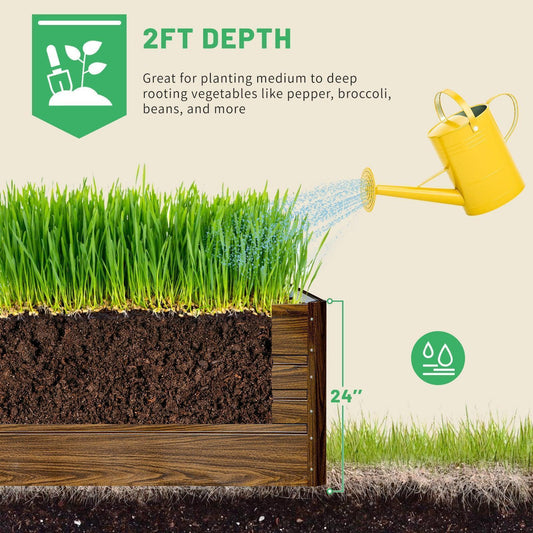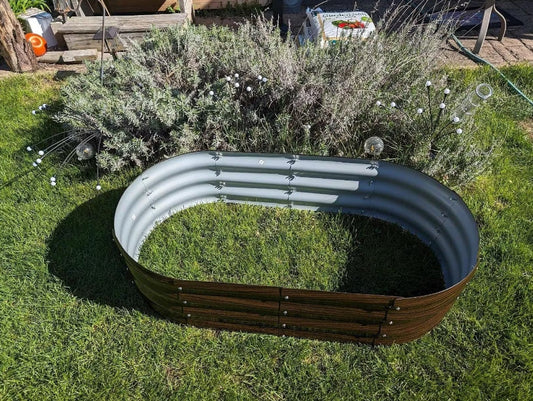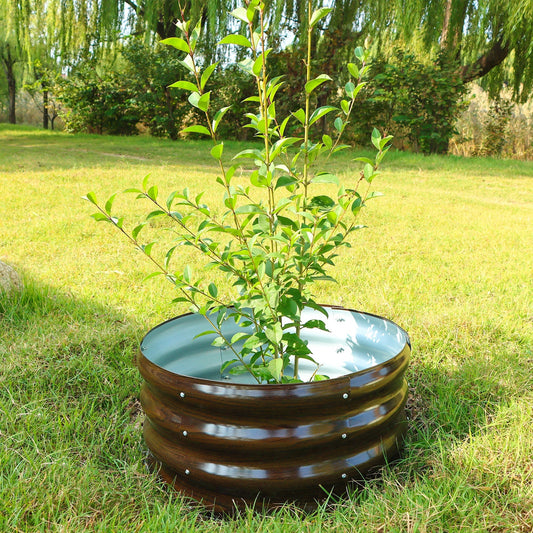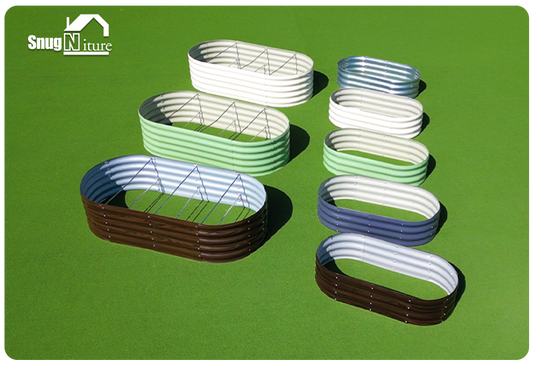Raised Bed Gardening: A Fresh Start for Veggies
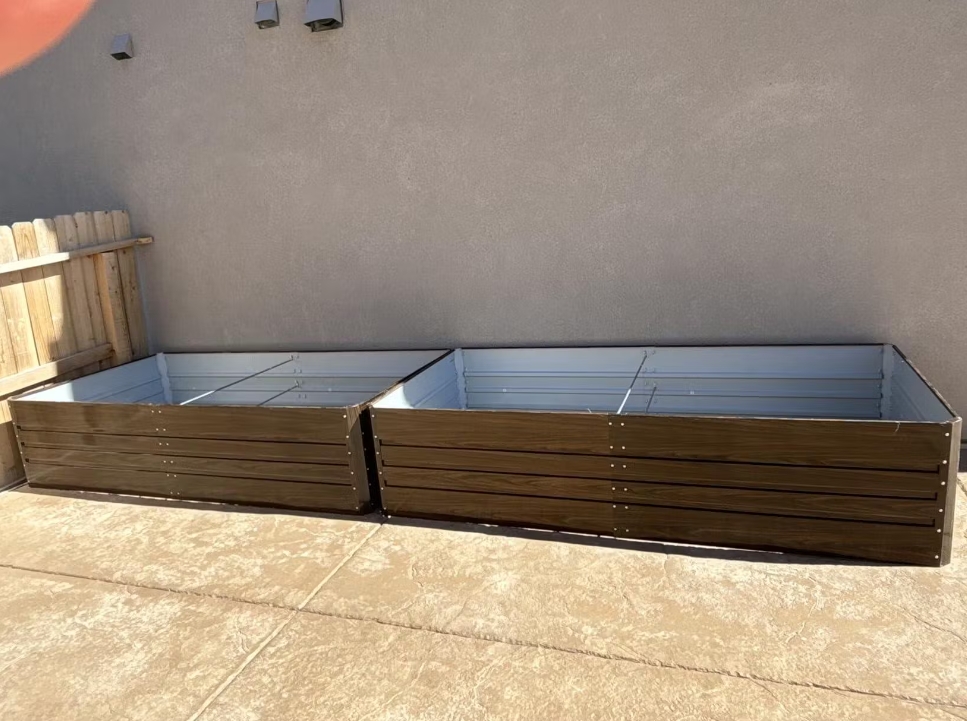
Raised bed gardening transforms how you grow vegetables. It’s easier to set up than traditional gardens, especially if you’re new to gardening. You can skip the tiller and use kits that require no construction skills. Plus, raised beds improve soil quality, reduce bending, and add charm to your outdoor space.
Key Takeaways
Raised bed gardening helps you manage soil and water better. This makes plants healthier and gives bigger harvests.
Pick a good spot for your raised beds. Make sure it gets enough sunlight and is easy to reach for care.
Check your soil often and add organic materials. This keeps the soil full of nutrients, which veggies need to grow well.
Benefits of Raised Bed Gardening
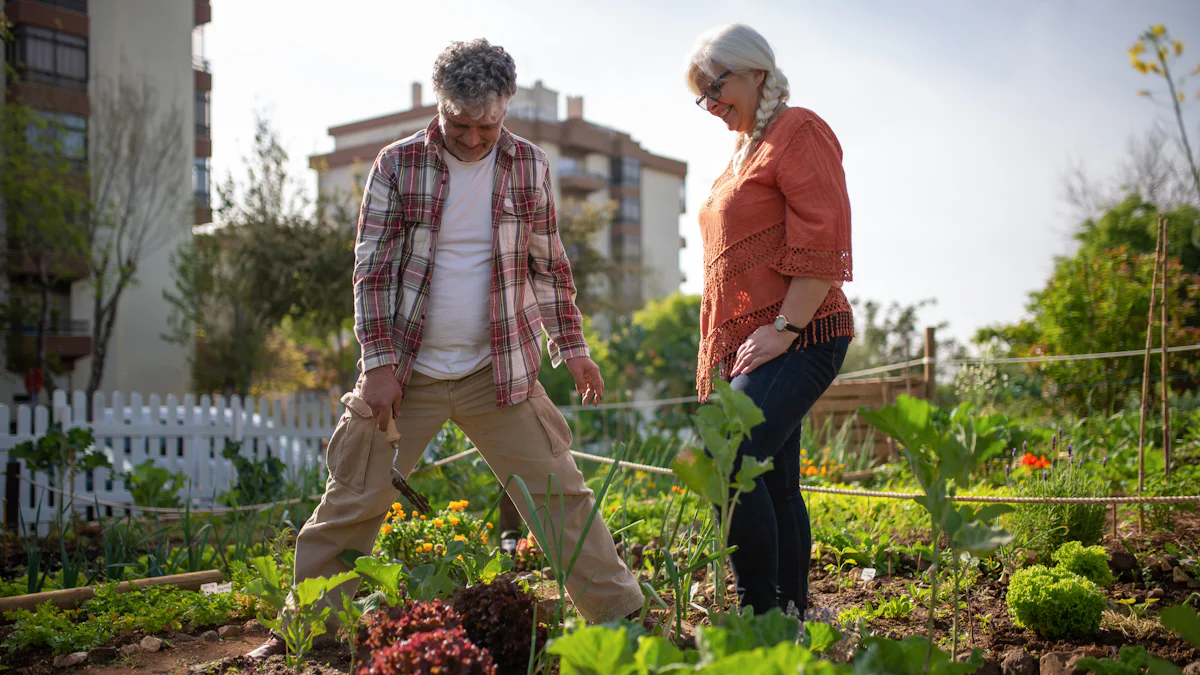
Better Soil Control and Drainage
Raised beds give you complete control over your soil. Unlike traditional gardening, where you’re stuck with whatever soil your yard offers, raised beds let you create the perfect mix. You can blend nutrient-rich soil with compost and other organic matter to give your plants the best start. Plus, raised beds drain water more effectively. This means no soggy roots or waterlogged plants, even after heavy rain. Your vegetables will thank you with healthier growth and vibrant harvests.
Easier Maintenance and Accessibility
Tired of endless weeding? Raised beds make maintenance a breeze. With proper care, weed populations decrease over time. You’ll spend less time pulling weeds and more time enjoying your garden. Raised beds also eliminate the need for seasonal tilling once the soil stabilizes. And if bending over is tough on your back, raised beds are a game-changer. You can customize the height to make gardening more comfortable and accessible for everyone.
Here’s a quick comparison:
Gardening Type |
Maintenance Time Required |
|---|---|
Raised Bed Gardening |
|
Traditional Gardening |
More frequent maintenance |
Higher Yields and Healthier Plants
Raised beds create the ideal environment for your vegetables to thrive. The controlled soil quality and better drainage lead to stronger, healthier plants. With fewer weeds competing for nutrients, your veggies grow faster and produce higher yields. You’ll enjoy a more productive vegetable garden layout without needing extra space.
Extended Growing Seasons
Want to start planting earlier in the spring? Raised beds warm up faster than traditional garden soil. This gives you a head start on the growing season. You can also extend your harvest into the fall by using covers or hoops to protect your plants from frost. Raised beds help you make the most of every growing season, giving you fresh produce for longer.
Planning Your Raised Bed Vegetable Garden
Choosing the Right Location
Picking the perfect spot for your raised beds is crucial. Here are a few things to keep in mind:
Sunlight Exposure: Your vegetables need at least six hours of direct sunlight daily. A south-facing area works best.
Proximity to Water: Make sure the location is close to a water source. This saves you from lugging heavy watering cans back and forth.
Convenience: Place your garden near your kitchen or a frequently visited area. This makes it easier to tend to your plants and harvest fresh produce.
Aesthetics: Choose a spot that blends well with your outdoor space. A well-placed garden can enhance the overall look of your yard.
Selecting the Ideal Size and Height
The size and height of your raised beds depend on your needs and space. Beds typically range from 6 to 8 inches in height, but taller options are available. Taller beds can keep small animals like rabbits out, while shorter ones let plant roots access native soil. If you’re growing deep-rooted vegetables, consider a height of 12 inches or more.
Raised beds also vary in width and length. A width of 3 to 4 feet allows you to reach the center without stepping on the soil. This prevents compaction and keeps your plants healthy. For length, go with what fits your space, but keep it manageable for maintenance.
Materials for Raised Beds (e.g., Snugniture Modular Metal Raised Garden Beds)
When it comes to materials, modular metal raised garden beds like Snugniture’s are a fantastic choice. They’re durable, corrosion-resistant, and eco-friendly. These beds are easy to assemble and require no special tools, making them perfect for beginners. Their modular design lets you customize the layout to fit your space, whether you’re creating a small herb garden or a large vegetable patch.
Snugniture beds also stand out for their aesthetics. With colors like Walnut, Pearly White, and Green, they add a stylish touch to your garden. Plus, their rounded corners make them safe and visually appealing. By using these raised beds, you can create a raised bed vegetable garden that’s not only functional but also beautiful.
Preparing the Soil for a Raised Bed Vegetable Garden
Creating Nutrient-rich Soil
The foundation of a thriving raised bed vegetable garden is nutrient-rich soil. You can’t just use any dirt; your plants need a balanced mix to grow strong and healthy. A good soil blend includes:
Clay
Silt
Sand
Organic matter
This combination ensures your soil retains moisture while staying loose enough for roots to spread. When filling your raised beds, aim for a mix of 60% topsoil, 30% compost, and 10% soilless growing medium like peat moss or coconut coir. This recipe creates the perfect environment for your vegetables to flourish.
Tip: Test your soil’s pH before planting. Most vegetables prefer a slightly acidic to neutral pH (6.0–7.0).
Ensuring Proper Drainage
Good drainage is essential for raised beds. Without it, your plants risk drowning in soggy soil. Start by layering the bottom of your beds with materials like:
Cardboard or landscape fabric to block weeds.
Twigs, small branches, and yard waste for the first layer.
Leaves, grass clippings, and compost for the second layer.
High-quality topsoil mixed with aged compost for the final layer.
This layered approach improves drainage and aeration while enriching the soil. If you’re using containers, drill drainage holes at the bottom and consider adding earthworms to enhance ventilation and nutrition.
Adding Organic Matter and Fertilizers
Organic matter is the secret ingredient for healthy soil. Add 2 to 3 inches of compost or well-rotted manure when filling the beds. Mix it thoroughly into the soil to boost fertility. If the organic matter isn’t fully composted, sprinkle nitrogen-rich fertilizers like blood meal to speed up decomposition.
Here’s a quick guide to fertilizers:
Fertilizer Type |
Amount per 100 sq. ft. |
|---|---|
Ammonium Sulfate (21-0-0) |
5 lbs |
Urea (46-0-0) |
2 lbs |
Blood Meal (12-2-1) |
8 lbs |
Note: Over-fertilizing can harm your plants. Follow the recommended amounts and adjust based on your soil test results.
By carefully preparing the soil, you’ll set the stage for a productive raised bed vegetable garden. Healthy soil means happy plants and a bountiful harvest!
Choosing Vegetables for Your Raised Bed
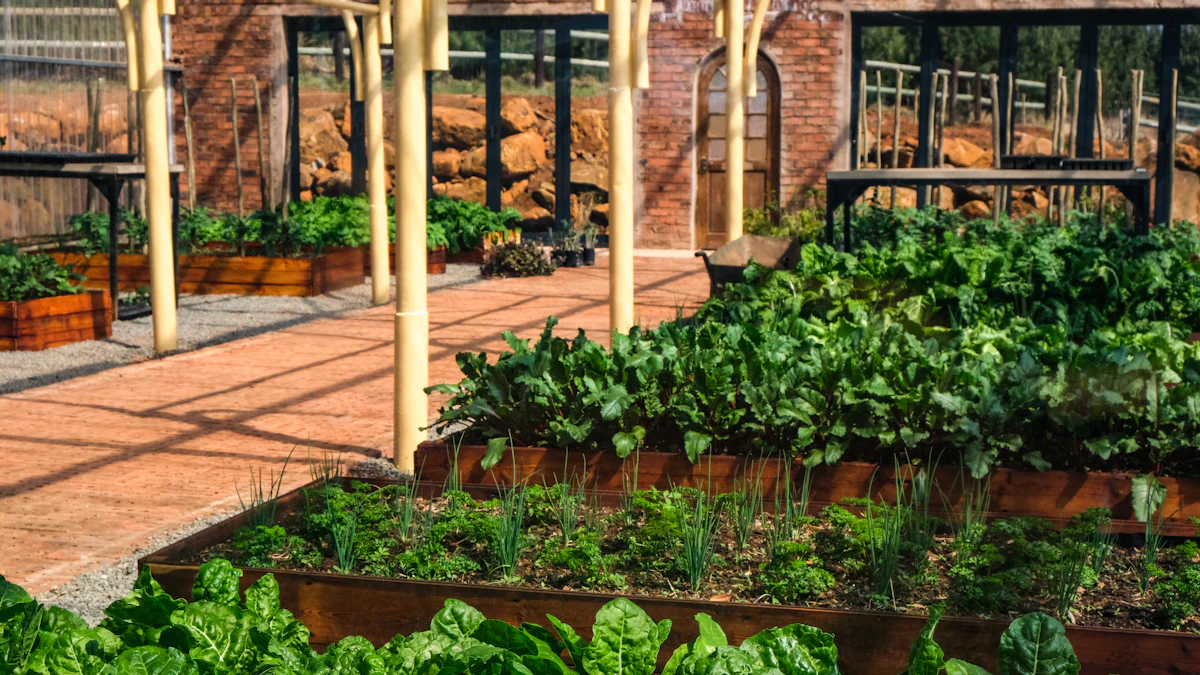
Best Vegetables for Raised Beds
Raised beds are perfect for growing a variety of vegetables. Their superior soil quality and excellent drainage create the ideal environment for plants to thrive. Some vegetables are especially well-suited for this method:
Radishes: These are low-maintenance and grow quickly, making them great for beginners.
Lettuce: It thrives in the customized soil of raised beds and has a short growing season.
Bush beans: These work well in raised beds and can be supported with trellises for better growth.
Kale: This nutrient-packed green grows beautifully in tailored soil conditions.
Raised beds also warm up faster in spring, giving you a head start on planting. This means you can enjoy fresh produce earlier in the season.
Seasonal Planting Tips
Planning your planting schedule is key to maximizing your harvest. Here are some tips to keep in mind:
Orientation Matters: Position your raised beds north-south to maximize sunlight exposure.
Crop Rotation: Change the location of your crops each year to prevent blight and maintain soil health.
Succession Planting: Plant small batches of crops every few weeks to enjoy a continuous harvest.
Intercropping: Grow different plants together to promote biodiversity and attract pollinators.
Don’t forget to reevaluate your planting schedule annually. Climate changes can affect weather patterns and pest activity, so adjust your plans accordingly.
Companion Planting for Better Growth
Companion planting is a smart way to boost your garden’s productivity. It increases biodiversity, attracts pollinators like bees, and provides natural pest control. Plus, it improves soil health by fixing nitrogen and reduces the need for chemical fertilizers.
Here are some winning combinations:
Marigolds with Tomatoes: Marigolds deter pests while attracting beneficial insects.
The Three Sisters (Corn, Beans, Squash): These plants support each other’s growth and maximize yield.
By pairing the right plants together, you’ll create a thriving small vegetable garden layout that’s both productive and sustainable.
Maintenance Tips for a Thriving Raised Bed Garden
Watering and Irrigation
Keeping your raised bed garden hydrated is essential for healthy plants. Drip irrigation systems are a fantastic option. They deliver water directly to the roots, ensuring efficient use and minimal waste. Components like mainline tubing, emitters, and a screen filter prevent clogging and keep the system running smoothly. You can even connect a drip hose to a spigot with a timer for automated watering.
If you prefer hand-watering, use a gentle spray attachment on your hose. This mimics rainfall and prevents soil erosion. Avoid overhead watering, as it can lead to uneven distribution and wasted water. For a DIY approach, consider setting up your own drip irrigation system—it’s easier than you think and can significantly improve your garden’s health and yields.
Managing Weeds and Pests
Weeds and pests can quickly take over if left unchecked. To manage them effectively:
Use row covers or netting to keep pests at bay.
Encourage natural predators like ladybugs and frogs.
Remove damaged plants and debris promptly to prevent infestations.
Regularly inspect your garden for signs of trouble.
Rotating crops also helps. Deep-rooted vegetables replenish nutrients and disrupt pest cycles, keeping your garden healthier.
Crop Rotation and Soil Health
Crop rotation is a simple yet powerful technique. It reduces soil pests and limits the spread of diseases. By alternating crops like legumes and leafy greens, you boost soil fertility and improve yields. This practice also ensures your soil stays balanced, giving your plants the best chance to thrive.
Regular Soil Testing and Amendments
Testing your soil regularly helps you understand its nutrient levels and pH. Most vegetables prefer a pH between 6.0 and 7.0. Based on the results, you can add amendments like compost, lime, or sulfur to adjust the soil. Healthy soil leads to stronger plants and a more productive garden.
By following these gardening tips, you’ll keep your raised bed garden thriving all season long.
Raised bed gardening offers long-term benefits that make it a rewarding choice for home gardeners. You’ll enjoy healthier plants, better yields, and easier maintenance. With tools like Snugniture Modular Metal Raised Garden Beds, you can create a garden that’s productive and accessible. Start small, experiment, and discover the joy of growing your own food! 🌱



